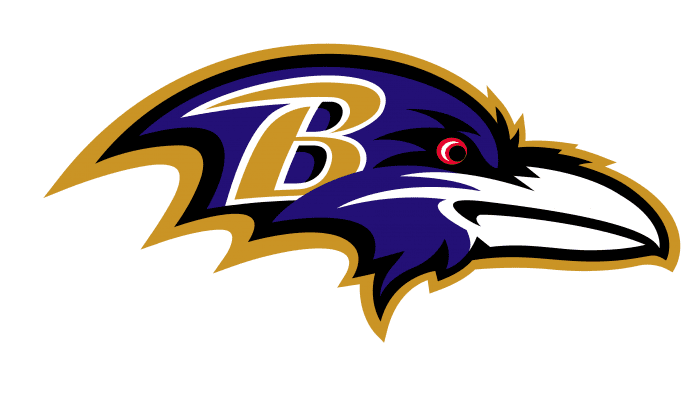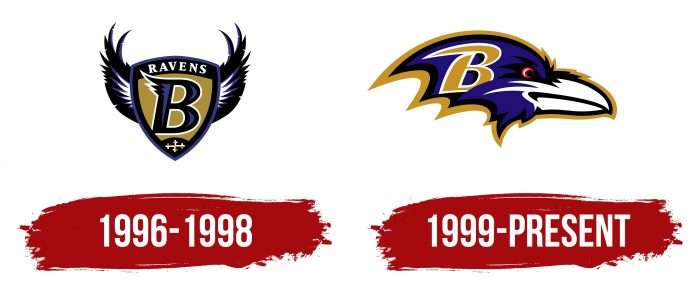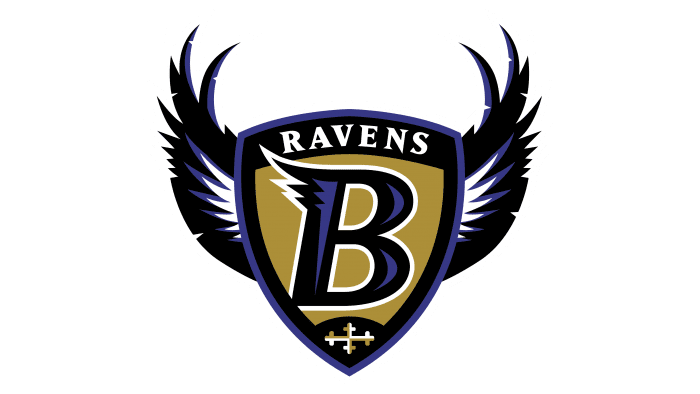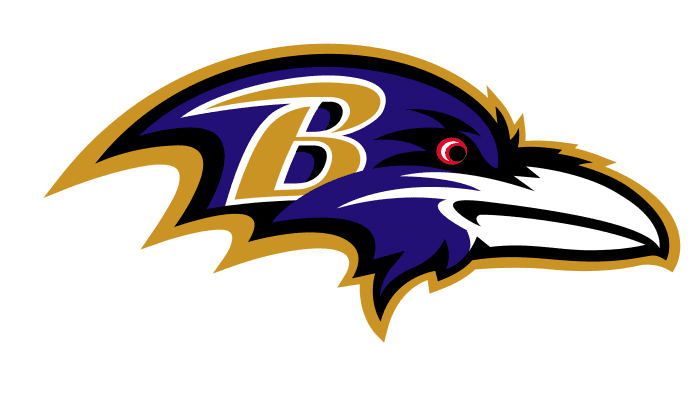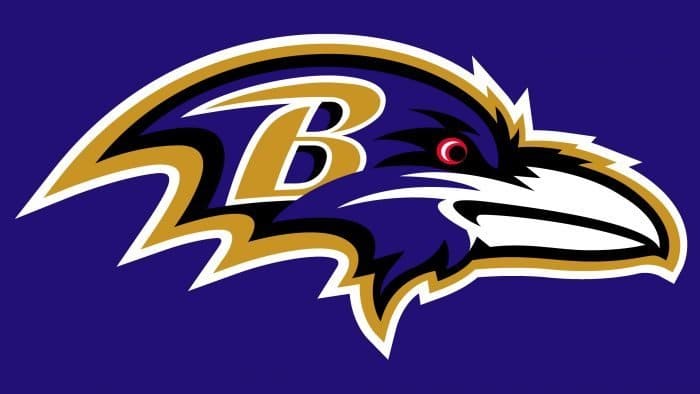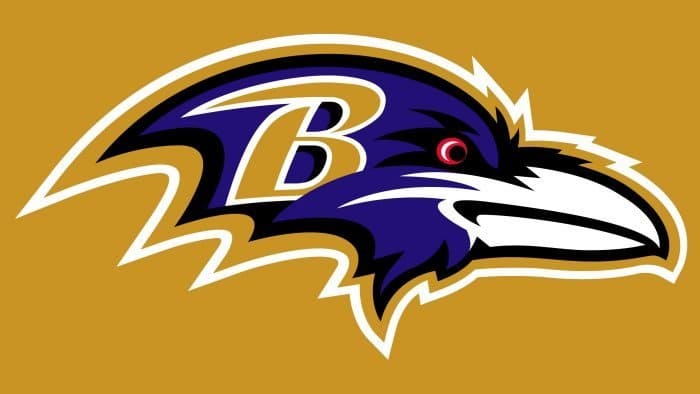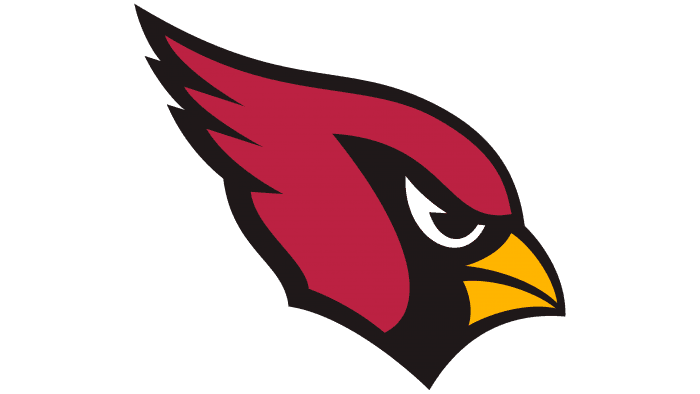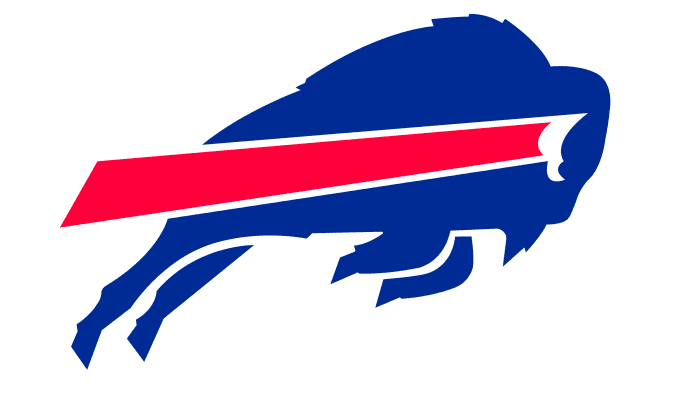The Baltimore Ravens logo symbolizes intelligence, collectivism, insight, belief in success, and constant hope for it. Established in 1996, the club’s style reflects the team’s colors and the brand’s main characteristics.
Baltimore Ravens: Brand overview
| Founded: | February 9, 1996 |
| Founder: | Steve Bisciotti |
| Headquarters: | Baltimore, Maryland, U.S. |
| Website: | baltimoreravens.com |
The Baltimore Ravens are a professional American football team that has competed in the National Football League since 1996. It was founded by Arthur Bertram (Art) Modell, who owned the Cleveland Browns for 35 years. He then faced financial difficulties when Cleveland authorities refused to pay for the stadium’s reconstruction.
On November 6, 1995, Art Modell announced his intention to move the team to Baltimore, where he was promised an annual operating subsidy of 25 million dollars. Despite controversies, the matter was settled: the “Cleveland Browns” stayed at home along with their uniform and awards. However, Art Modell retained the existing player contracts and received a new franchise. Thus, Baltimore got an NFL football team for the first time in 13 years since the “Baltimore Colts” moved to Indianapolis.
Arthur Bertram gave up his right to the Browns, and he couldn’t acquire the nickname Colts. The nickname Ravens was chosen as a result of a contest and announced on March 29, 1996. The initial list consisted of more than 100 nicknames. Organizers reduced it to 17 and focus group representatives to 6. People participating in a phone survey preferred three options: Ravens, Americans, and Marauders. After announcing the shortlist, the Baltimore Sun held a contest among fans: more than 21,000 out of 33,000 people voted for the Ravens. This nickname refers to Edgar Allan Poe’s poem “The Raven,” whose author was born and buried in Baltimore.
Due to constant financial difficulties, the NFL instructed Art Modell to initiate the sale of his franchise. On March 27, 2000, NFL owners approved the sale of 49% of the “Ravens” shares to Steve Bisciotti, who already owned a small stake. On April 9, 2004, the NFL approved the businessman’s purchase of the controlling stake in the club. The former club owner retained 1% of the shares and continued working at the headquarters as a consultant.
Meaning and History
Since 1996, the “Baltimore Ravens” have had two logos. The first had to be changed due to a court decision over copyright infringement. The plaintiff was Frederick Bouchat, an amateur artist from Maryland. Frederick Bouchat was convinced he had seen this design with a winged shield and the letter “R” somewhere before, specifically among his works. Before the football club’s opening, he sent his winged shield design to Maryland’s stadium administration by fax. In exchange for the design, he requested a helmet with an autograph. On June 5, 1996, the club introduced a similar logo, but the designer’s request was not fulfilled. The legal proceedings lasted more than ten years. The court ruled that the Baltimore Ravens must pay the copyright holder $100 for each use of this image during future NFL games. Eventually, it changed its brand name, maintaining a connection with the raven theme.
What is Baltimore Ravens?
The “Baltimore Ravens” is a team that joined the National Football League in 1996. Since 2002, they have been competing in the Northern Division, previously playing in the AFC Central. The team’s headquarters is located in the Baltimore suburb of Owings Mills.
1996 – 1998
The first logo of the “Baltimore Ravens” – the infamous “Flying B.” According to the management of the “Baltimore Ravens,” it was made independently of Frederick Bouchat. The central element is a shield that pays homage to Baltimore’s heraldry. Its triangular and pointed shape is characteristic of the old French heraldic traditions of the 13th and 14th centuries. It’s colored in the official team colors: purple, black, and metallic gold.
In the center of the shield is the capital letter “B” (meaning “Baltimore”), with three tildes of varying lengths. It’s framed by the word “Ravens” at the top and a cross at the bottom. This cross comes from runic signs and belongs to early Western European heraldic art. The emblem features raven wings spread over the shield.
1999 – today
The current symbol of the football club was introduced in 1999 and has not changed since. It proves its complete conformity with the concept of Baltimore Ravens: the emblem features a raven and a reference to the city’s name. Over 20-plus years, it has become iconic and is now firmly associated with the team, preventing them from abandoning it and developing a radically new design. Thus, the football players’ uniforms have been adorned with the image of a bird’s head with the letter “B” on the side for two decades.
Baltimore Ravens fans chose it: The Baltimore Sun conducted a poll, offering three new logo options. The football team abandoned the heraldic format and preferred the Denver Broncos style. The new Baltimore Ravens emblem features a profile of a raven’s head. The colors remained the same, but black was used only for borders. The letter “B” with one tilde is superimposed on the left side of the raven’s head. Club owner Art Modell himself insisted on its presence.
Baltimore Ravens: Interesting Facts
The Baltimore Ravens are a football team that started in 1996 in Baltimore, Maryland. They are known for being good at defense, having enthusiastic fans, and winning quickly.
- How They Got Their Name: “Ravens” comes from a poem called “The Raven” by Edgar Allan Poe, who lived in Baltimore. The name was picked by people voting in the Baltimore Sun newspaper, showing how much Baltimore likes Poe’s work.
- Winning the Super Bowl: They won twice, once in 2000 against the New York Giants and again in 2012 against the San Francisco 49ers.
- Amazing Defense: In 2000, their defense was so good they set a record for allowing the fewest points in a season. Ray Lewis led this defense.
- Ray Lewis: Speaking of Ray Lewis, he’s one of the best players to ever play for the Ravens, winning many awards during his 17 years with the team.
- Starting the Team: Art Modell created the Ravens by moving his team from Cleveland to Baltimore in 1996. This move was big news, and Cleveland kept the Browns’ name and history for a new team later.
- Mascots: They have three mascots named Edgar, Allan, and Poe, which is a fun nod to Edgar Allan Poe.
- The Harbaugh Bowl: The Ravens won a Super Bowl in which the two teams’ coaches were brothers—John Harbaugh for the Ravens and Jim Harbaugh for the 49ers. This was a big deal.
- Helping Out: The Ravens do a lot for their community through the Ravens Foundation, especially focusing on health, education, and fitness for kids.
- Ravenstown: This is what they call their fan community, showing how much the fans love their team.
- Breaking Records: They’ve had players set records, like Justin Tucker, who kicked the longest field goal in the NFL at 66 yards.
- Big Rivalries: Their games against the Pittsburgh Steelers are always intense because they are big rivals, making them very exciting.
Even though the Ravens haven’t been around as long as some other teams, they’ve made a big mark on football with their wins, community work, and connection to Edgar Allan Poe.
Font and Colors
The raven is the eternal theme of the “Baltimore Ravens,” reflected in both club emblems. But if the focus was previously on the wings, now the blue head with a large white beak occupies the center. Moreover, artists deliberately highlighted the eye in red to emphasize hidden aggression. The letter “B” – the first in the word “Baltimore” – is located on the left part of the logo.
The letter “B” was hand-drawn, and the artists did not use standard fonts for its creation. They were guided only by their ideas and the wishes of the football club’s leaders. The letter is unusually stylized: it has no serifs but has an extended horizontal line at the top. Meanwhile, the white outline around “B” complements the primary gold color. The palette of the logo also includes dark blue, red, and black. Designers managed to combine shades so that the overall composition looked cohesive and harmonious.
Baltimore Ravens color codes
| Black | Hex color: | #000000 |
|---|---|---|
| RGB: | 0 0 0 | |
| CMYK: | 70 50 50 100 | |
| Pantone: | PMS Process Black C |
| Purple | Hex color: | #241773 |
|---|---|---|
| RGB: | 26 25 95 | |
| CMYK: | 100 100 0 5 | |
| Pantone: | PMS 273 C |
| Metallic Gold | Hex color: | #9e7c0c |
|---|---|---|
| RGB: | 187 147 52 | |
| CMYK: | 0 20 80 20 | |
| Pantone: | PMS 8660 C Metallic |
FAQ
What does the Baltimore Ravens logo mean?
The raven’s head illustrates the team’s name and mascot, and the letter “B” represents the city of Baltimore. The bird looks menacing to demonstrate the spirit of rivalry and the drive to win. The palette corresponds to the official color scheme of the Baltimore Ravens.
Why did the “Ravens” change their logo?
The team had to abandon the first logo due to a court decision, as they were accused of copyright infringement. An artist filed a lawsuit against the “Baltimore Ravens” for allegedly stealing his idea when he sent them a sketch of the emblem, asking to exchange it for a helmet with an autograph. The club representatives not only didn’t give the artist a helmet but also appropriated his work.
Did the “Titans” trample on the “Ravens'” emblem?
Yes, the Tennessee Titans stepped on the Baltimore Ravens logo on the football field to demonstrate their superiority and disrespect. The Ravens retaliated: they defeated their rivals and danced the victory dance on their logo. Because of this, Marcus Peters from “Baltimore” was fined $15,000.
How did the Baltimore Ravens get their logo?
When the court ruled that the Baltimore Ravens must pay Frederick Bouchat $100 for each use of the winged shield logo, it was decided to change the design. This led to the creation of a new emblem that exists to this day. It features a raven’s head with a red eye, blue feathers, a white beak, and a wide golden outline.
